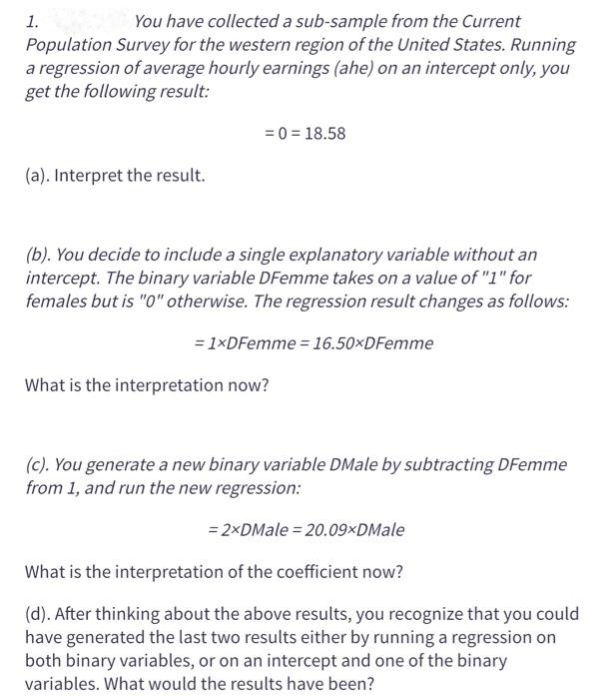You have collected a sub-sample from the Current Population Survey for the western region of the United States. Running a regression of average hourly earnings (ahe) on an intercept only, you get the following result: 1. (a). Interpret the result. = 0 = 18.58 (b). You decide to include a single explanatory variable without an intercept. The binary variable DFemme takes on a value of "1" for females but is "0" otherwise. The regression result changes as follows: = 1xDFemme = 16.50×DFemme What is the interpretation now? (c). You generate a new binary variable DMale by subtracting DFemme from 1, and run the new regression: = 2xDMale = 20.09xDMale What is the interpretation of the coefficient now? (d). After thinking about the above results, you recognize that you could have generated the last two results either by running a regression on both binary variables, or on an intercept and one of the binary
You have collected a sub-sample from the Current Population Survey for the western region of the United States. Running a regression of average hourly earnings (ahe) on an intercept only, you get the following result: 1. (a). Interpret the result. = 0 = 18.58 (b). You decide to include a single explanatory variable without an intercept. The binary variable DFemme takes on a value of "1" for females but is "0" otherwise. The regression result changes as follows: = 1xDFemme = 16.50×DFemme What is the interpretation now? (c). You generate a new binary variable DMale by subtracting DFemme from 1, and run the new regression: = 2xDMale = 20.09xDMale What is the interpretation of the coefficient now? (d). After thinking about the above results, you recognize that you could have generated the last two results either by running a regression on both binary variables, or on an intercept and one of the binary
Managerial Economics: Applications, Strategies and Tactics (MindTap Course List)
14th Edition
ISBN:9781305506381
Author:James R. McGuigan, R. Charles Moyer, Frederick H.deB. Harris
Publisher:James R. McGuigan, R. Charles Moyer, Frederick H.deB. Harris
Chapter4A: Problems In Applying The Linear Regression Model
Section: Chapter Questions
Problem 5E
Related questions
Question
Please no written by hand solution

Transcribed Image Text:You have collected a sub-sample from the Current
Population Survey for the western region of the United States. Running
a regression of average hourly earnings (ahe) on an intercept only, you
get the following result:
1.
(a). Interpret the result.
= 0 = 18.58
(b). You decide to include a single explanatory variable without an
intercept. The binary variable DFemme takes on a value of "1" for
females but is "0" otherwise. The regression result changes as follows:
= 1xDFemme = 16.50×DFemme
What is the interpretation now?
(c). You generate a new binary variable DMale by subtracting DFemme
from 1, and run the new regression:
= 2xDMale = 20.09xDMale
What is the interpretation of the coefficient now?
(d). After thinking about the above results, you recognize that you could
have generated the last two results either by running a regression on
both binary variables, or on an intercept and one of the binary
variables. What would the results have been?
Expert Solution
This question has been solved!
Explore an expertly crafted, step-by-step solution for a thorough understanding of key concepts.
Step by step
Solved in 5 steps

Knowledge Booster
Learn more about
Need a deep-dive on the concept behind this application? Look no further. Learn more about this topic, economics and related others by exploring similar questions and additional content below.Recommended textbooks for you

Managerial Economics: Applications, Strategies an…
Economics
ISBN:
9781305506381
Author:
James R. McGuigan, R. Charles Moyer, Frederick H.deB. Harris
Publisher:
Cengage Learning

Managerial Economics: Applications, Strategies an…
Economics
ISBN:
9781305506381
Author:
James R. McGuigan, R. Charles Moyer, Frederick H.deB. Harris
Publisher:
Cengage Learning